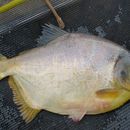en
names in breadcrumbs


Piaractus mesopotamicus, the small-scaled pacu, Paraná River pacu or simply pacu (a name shared with other species), is a South American ray-finned fish that is native to the Paraguay-Paraná River basin,[2][3] but it has been introduced by aquaculture activities in a wider area.[4] In its native range it is also known as the pacú chato, pez chato ("flat fish") or mbiraí-piraí.[5]
Piaractus mesopotamicus is a robust fish, with ovoid shape, flattened laterally. Its colour is dark grey to silver, with a white belly and a yellow breast.[2] It reaches up to 62 cm (2.03 ft) in length[4] and 20 kg (44 lb) in weight.[2] The other member of its genus, P. brachypomus, can be distinguished by its larger scale-size[6] and the lower number of lateral scales (less than 110).[7]
Piaractus mesopotamicus is an omnivore.[4] Young individuals usually feed on micro-crustaceans, while adults feed on plant material and insects.[4] Main food items for adults are nuts and seeds that fall from trees in flooded forests.[2] It tolerates water temperatures between 15 and 35 °C (59–95 °F), but stops feeding when it falls below 18 °C (64 °F).[4]
Piaractus mesopotamicus, the small-scaled pacu, Paraná River pacu or simply pacu (a name shared with other species), is a South American ray-finned fish that is native to the Paraguay-Paraná River basin, but it has been introduced by aquaculture activities in a wider area. In its native range it is also known as the pacú chato, pez chato ("flat fish") or mbiraí-piraí.
Piaractus mesopotamicus is a robust fish, with ovoid shape, flattened laterally. Its colour is dark grey to silver, with a white belly and a yellow breast. It reaches up to 62 cm (2.03 ft) in length and 20 kg (44 lb) in weight. The other member of its genus, P. brachypomus, can be distinguished by its larger scale-size and the lower number of lateral scales (less than 110).
Piaractus mesopotamicus is an omnivore. Young individuals usually feed on micro-crustaceans, while adults feed on plant material and insects. Main food items for adults are nuts and seeds that fall from trees in flooded forests. It tolerates water temperatures between 15 and 35 °C (59–95 °F), but stops feeding when it falls below 18 °C (64 °F).